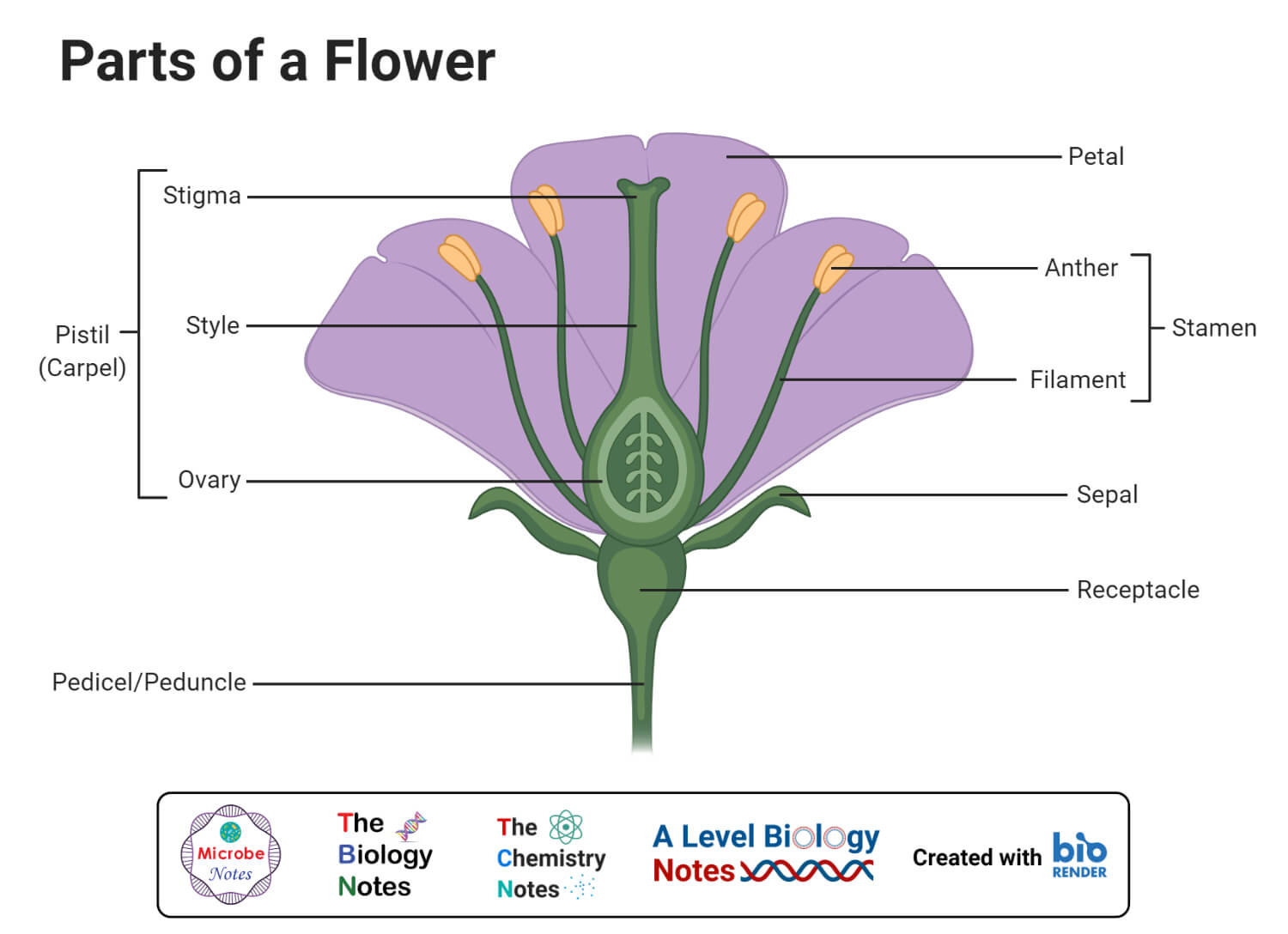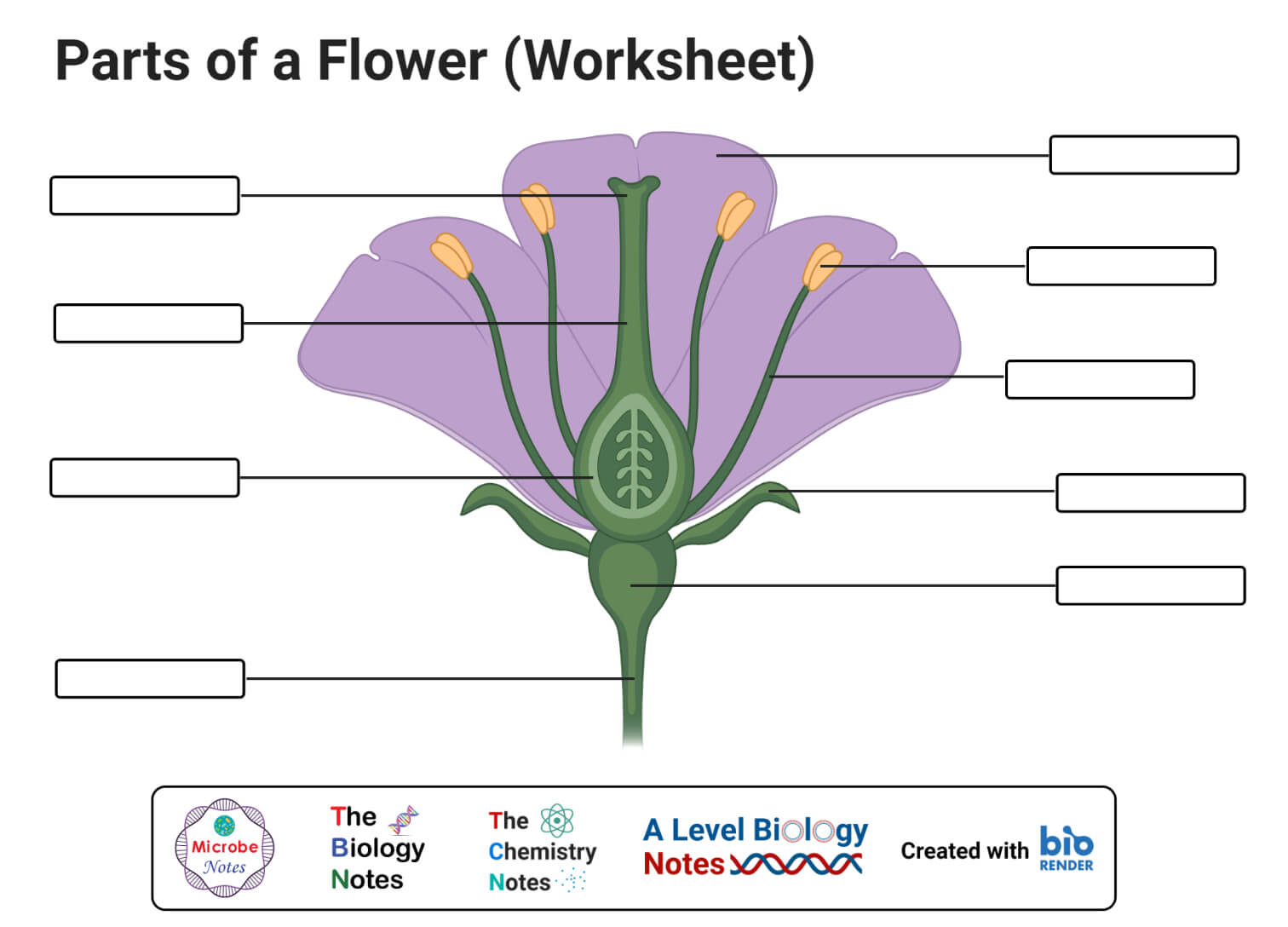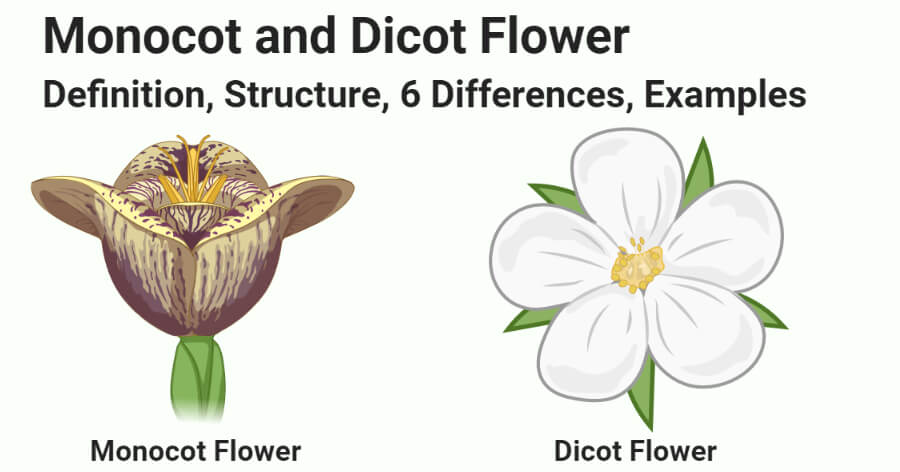Interesting Science Videos
Definition of Monocot Flower
Monocot flowers are condensed shoot regions that are specialized for the function of sexual reproduction.
- The most definitive characteristic of monocot flowers is that these flowers usually have flower parts that occur in threes or multiples of threes.
- The observation of flowers and their parts; thus, can be used as a method to differentiate between monocot and dicot plants.
- Even though the general pattern of floral parts is similar in all monocot plants, the color, size, form, and anatomical arrangement of the flowers vary greatly among different species.
- Monocot flowers have a similar structure to dicot flowers consisting of vegetative parts and reproductive parts.
- The vegetative parts consist of calyx and corolla which are involved in providing protection to the reproductive parts and attracting different pollinators. Most of the monocot flowers pollinate via wind and water as the flowers are smaller in size and thus, light.
- In some monocot flowers, the calyx and corolla are undifferentiated, and a structure perianth is present.
- Most of the monocot flowers are complete flowers with all four floral members. The number and arrangement of the parts, however, might vary.
- The part in the stem from where the flowers arise is called a bract. The size of the flower depends on the length of the flower stalk called a pedicel.
- The thick upper part of the pedicel where the floral parts exist is called the thalamus. The size of the thalamus also varies among species and even within the same plant depending on the stage of the flower.
Definition of Dicot Flower
The dicot flower is the reproductive part of the plant, which is characterized by the presence of flower parts that occur in multiples of four or five.
- The number of flower parts or floral leaves helps in the differentiation of plants into monocot and dicot. The differentiation is not always reliable as in some plants, the flowers can be reduced or have numerous parts.
- Dicot flowers are mostly complete and unisexual flowers consisting of all four whorls of the flower.
- Another important measure of differentiation of dicot flowers is the presence of triporate pollen structure with three furrows or pores in the pollen.
- The color, shape, symmetry, and size of the flower differs within dicot plants or even within the same species. The two most common forms of symmetry in dicot flowers are radial symmetry and bilateral symmetry.
- The most important function of flowers is sexual reproduction, and thus, the structure of the flowers can be modified according to the reproductive habit of the plant.
- Dicot flowers occur in the bract region of the stem which is attached to the stem by the means of the pedicel. The pedicel occurs as a long stalk that supports different parts of the flowers.
- Dicot flowers are usually pollinated by insects and animals as they are large and colorful.
Structure of Monocot and Dicot Flower
Monocot and dicot flowers consist of the same set of parts, but the number and arrangement of the parts might be different. The structure of monocot and dicot flower can be explained as the following parts;
1. Petal
- Petals are the unit of the corolla in flowers which is the second whorl of a flower. The whorl is present above the calyx, which is the first whorl of the flower.
- Petals are flower leaves that are typically thin, soft, and colored to attract different pollinators like animals and insects.
- The most important function of petals is to attract different pollinators for pollination and to protect the reproductive units of the flower.
- The shape and size of the petals might or might not be uniform in the flower. If the shape and size of petals are uniforms, such flowers are termed symmetrical flowers whereas flowers with different petals are termed asymmetrical flowers.
- In some flowers, petals might be fused to form a singular unit, and the condition is called gamopetalous.
- The differentiation of monocot and dicot plants can be done on the basis of a number of petals. In dicots, the number of petals is either four or five or their multiples. In monocots, the number of petals is three or multiples of three.
- The difference in the number of petals is the basis for the differentiation of monocot and dicot flowers.

2. Stamen
- Stamens are the male reproductive parts of flowers that are morphologically similar to microsporophylls.
- Stamens together form the androecium that forms the third whorl of the flower. The stamens in the androecium can be fertile or sterile. The fertile stamens produce pollen grains, whereas the sterile stamens are caked staminodes.
- Some plants might even have brightly colored stamens that look like petals. These are termed petaloid stamens and occur in plants like Canna.
The number of stamen in monocot is either three or its multiples and consists of two distinct parts;
a. Anther
- The anther is the terminal fertile part of a stamen which encloses microsporangia that produce and store microspores or pollen grains.
- A single anther consists of distinct microsporangia that form sacs or pockets (also called anther sacs or pollen sacs) in the anther. The number of microsporangia is different in different plants.
- The microsporangium is lined with a layer of nutritive tissue called tapetum that enclosed the pollen mother cells.
- The cells undergo meiosis cell division to form haploid microspores. The microspores can either exist as individual units or together in the tetrad form.
- The microspore then divides mitotically to form an immature microgametophyte, which is called the pollen grain.
- The anther consists of an opening that enables the release of these pollen grains. The pollen grains also have openings or furrows required for successful fertilization.
- Monocot and dicot flowers can be differentiated on the basis of the number of furrows present on the pollen grains. Monocot pollen grains have a single opening or furrow whereas dicot pollen grains have three distinct furrows or openings.
b. Filament
- The filament is a stalk that connects the anther to the rest of the parts of the flower. The filament is connected to the anther via a connective which is an extension of the filament consisting of conducting strands.
- A single filament is always attached to a single anther, which together form the stamen.
3. Pistil (Carpel)
- Pistil or carpel is the female reproductive part in plants that is centrally located and comprises the central or innermost whorl of the flower.
- The pistil is structurally identical to the megasporophyll in plants that carries the female reproductive gametes that collectively form the gynoecium. The gynoecium might be composed of one or more separate pistils.
- The pistil is considered to be composed of carpels where a single pistil might have one carpel with the ovary and other structures, or multiple carpels joined together with a single ovary.
The pistil consists of the following structures;
a. Stigma
- The stigma is the apical round or flat region of the pistil which receives the pollen during pollination.
- The stigma is often sticky or feathery to capture the pollen grains. The pollen grains land on the stigma, which are then moved on to other regions of the pistil.
b. Style
- The style is the long pillar-like stalk of the pistil through which the pollen tube grows that passes the pollen grains from the stigma to the ovary.
- Some plants might not have a style as the stigma might sit directly on to the ovary.
- The style, when present, is a hollow tube that enables the formation of a pollen tube during fertilization.
c. Ovary
- The ovary is the swollen basal portion of the pistil that consists of ridges of tissues bearing one or more eggs or ovules.
- The ovules remain within the chamber in the ovary called the locule or cell. The ovules are born on the gynoecial appendages.
4. Sepal
- The sepal is the unit of the calyx, which is a vegetative part of the flower that protects the flower in the bud as well as the final stage of flowering.
- The sepals collectively form the calyx, which is the outermost whorl of a flower. The calyx is very prominent during the bud stage of the flower, but it either withers or becomes vestigial after flowering.
- The sepals, like petals, are modified leaves that, together with the petals, form the outer sterile part portion called the perianth.
- The number of sepals present in flowers is called its merosity which is often used to differentiate plants into different groups.
- In some plants, the term tepal is used when the sepal and petal are of the same color or when sepals are colorful, and petals are absent.
5. Receptacle
- Receptacle or torus is the swollen part of the pedicel to which different parts of the flower are attached.
- In some flowers, the receptacle might form some edible part of the fruit while in others is it reduced after fertilization.
6. Pedicel/Peduncle
- The pedicel is the stalk that connects the flower to the stem, which is composed of the same set of tissues as the stem.
- In some plants, pedicel might be absent, and such flowers are termed sessile flowers as they are directly attached to the stem or branches.
Parts of a flower free worksheet

Functions of Monocot and Dicot Flower
The following are the common functions of monocot and dicot flowers;
- Different colors and shapes of flowers attract different pollinators like insects and animals for pollination.
- Flowers consist of the reproductive units of the flower that are essential for sexual reproduction in plants.
- Flowers are often used as ornaments or decorative items during functions and rituals in different cultures.
- Flowers of some plants might contain nectar which provides food to different insects which then help in the transfer of pollen grains.
- The flowers eventually lead to the formation of fruits which are used as a source of food and nutrients.

Monocot Flower vs Dicot Flower (6 Key Differences)
| Characteristics | Monocot Flower | Dicot Flower |
| Definition | Monocot flowers are condensed shoot regions that are specialized for the function of sexual reproduction. | The dicot flower is the reproductive part of the plant, which is characterized by the presence of flower parts that occur in multiples of four or five. |
| Number of flower parts | Monocot flower has flower parts that occur in threes or multiples of threes. | Dicot flowers have flower parts that occur in fours and fives or their multiples. |
| Petals | The number of petals in monocot flowers usually is either three or six. In some cases, the petals might be fused. | The number of petals in dicot flowers is four or five or their multiples. |
| Pollen grains | Pollen grains of monocot flowers have a single pore or furrow. | Pollen grains of dicot flowers have three pores or furrows. |
| Perianth | Some monocot plants might have a perianth (undifferentiated calyx and corolla). | Dicot plants have differentiated calyx and corolla. |
| Pollination | Most of the monocot flowers are usually wind-pollinated. | Most of the dicot flowers are usually insect-pollinated. |
Read Also: Monocot vs Dicot Leaves- Definition, Structure, 13 Differences, Examples
Examples of Monocot Flower
1. Tulip flowers
- A tulip is a large group of plants consisting of about 3000 varieties of flowering plants. Tulip blossoms exist in almost all colors except blue.
- The size, shape, and form of tulips differ depending on the cultivar. However, in general, tulips occur as cup-shaped blossoms.
- All tulip flowers consist of six petals that are either smooth or ruffled. In some tulips, the petals are single-colored whereas, in others, they are striped, swirled, or faded at the margin.
- The flowers contain six sepal units that are present at the base of the flower after the flower is in its final stage.
- Some tulip species might have tepals or perianth instead of differentiated petals and sepals.
2. Daffodil flower
- Daffodil flowers are unique to most monocot flowers due to the presence of both a perianth and a corona.
- The corona is the cup-shaped region of the flower which differentiates the flower from other flowers and makes it more attractive.
- The corona is made up of a thin and soft petal-like structure with frilled edges that surround the stamens.
- There are six petals that together form a perianth. The perianth surrounds the corona resulting in a trumpet-like flower.
Examples of Dicot Flower
1. Sunflower
- The flower of the sunflower plant consists of a flower head with individual disc flowers, and the disk flowers are in different stages of development.
- The colorful outer part of the flower is composed of ray flowers that have five elongated petals united to form straplike structures.
- The ray flowers are usually golden but orange-yellow and reddish variation might also exist.
- The rest of the flower with the large discoidal head is made up of disk flowers. A single disk flower is referred to as floret.
- The florets are epigynous with the petal and stamen attached to the ovary. Each of the florets is then surrounded by a sharp bract, a basal ovary ad scales. The corolla of the florets is composed of five fused petals.
- The florets are arranged in the head in the form of radiating arcs from the center of the head.
2. Marigold flower
- A marigold flower is a cluster of many flowers that are complex with disk florets and ray flowers.
- The outer region of the flower consists of ray flowers. The ray flowers are usually darker in color and consist of stamen attached to them.
- The disc florets are present in the middle of the flower, which is lighter and contains a single stamen in the center.
- The ray florets and disc florets are all bond at the base of the flower, called the receptacle. The receptacle and the lower tubular region of the flowers are covered by the fused calyx.
References
- Smyth, David R. “Morphogenesis of flowers–our evolving view.” The Plant cell vol. 17,2 (2005): 330-41. doi:10.1105/tpc.104.030353
- Scutt, Charlie P, and Michiel Vandenbussche. “Current trends and future directions in flower development research.” Annals of botany vol. 114,7 (2014): 1399-406. doi:10.1093/aob/mcu224
- Seiler, G.J. (1997). Anatomy and Morphology of Sunflower. In Sunflower Technology and Production, A.A. Schneiter (Ed.). https://doi.org/10.2134/agronmonogr35.c3
- 1% – https://www.brighthubeducation.com/science-homework-help/116499-parts-of-a-flower/
- 1% – https://microbenotes.com/monocotyledons-vs-dicotyledons/
- 1% – https://en.wikipedia.org/wiki/Anther
- <1% – https://www.toppr.com/guides/biology/anatomy-of-flowering-plants/anatomy-of-dicotyledonous-and-monocotyledonous-plants/
- <1% – https://www.slideshare.net/BiswarupMajumder/the-flower-102639734
- <1% – https://www.researchgate.net/publication/344854126_Stability_Despite_Reduction_Flower_Structure_Patterns_of_Receptacle_Elongation_and_Organ_Fusion_in_Eriocaulon_Eriocaulaceae_Poales
- <1% – https://www.proflowers.com/blog/flower-anatomy
- <1% – https://www.pickupflowers.com/flower-guide/daisies
- <1% – https://www.gardenguides.com/95931-list-dicot-flowers.html
- <1% – https://www.gardenguides.com/114395-sunflower-plant-growth-stages.html
- <1% – https://www.first-learn.com/types-of-flower.html
- <1% – https://www.differencebetween.com/difference-between-eudicots-and-monocots/
- <1% – https://www.diffen.com/difference/Dicot_vs_Monocot
- <1% – https://www.cs.mcgill.ca/~rwest/wikispeedia/wpcd/wp/f/Flower.htm
- <1% – https://www.britannica.com/science/sepal
- <1% – https://www.britannica.com/science/ovary-plant
- <1% – https://www.askiitians.com/biology/morphology-of-flowering-plants/flower.html
- <1% – https://www.answers.com/Q/What_happens_after_a_pollen_grain_lands_on_a_stigma
- <1% – https://www.answers.com/Q/What_does_a_filament_do_in_plants
- <1% – https://ucmp.berkeley.edu/glossary/gloss8/monocotdicot.html
- <1% – https://quizlet.com/122631150/lab-3-sexual-reproduction-in-flowering-plants-flash-cards/
- <1% – https://plantspedia.fandom.com/wiki/Receptacle
- <1% – https://encyclopedia2.thefreedictionary.com/pistil
- <1% – https://en.wikipedia.org/wiki/Tepal
- <1% – https://en.wikipedia.org/wiki/Petal
- <1% – https://en.wikipedia.org/wiki/Gynoecium
- <1% – https://en.wikipedia.org/wiki/Flower
- <1% – https://byjus.com/biology/difference-between-dicot-and-monocot-root/
- <1% – https://brianmccauley.net/bio-6a/bio-6a-lab/plants/stems
- <1% – https://botanyprofessor.blogspot.com/2012/07/symmetry-of-plants.html
- <1% – https://aminghori.blogspot.com/2016/03/normal-0-false-false-false-en-us-x-none.html
- <1% – http://www.flowers-gardens.net/gardens/flowers-of-monocots-and-dicots.html
